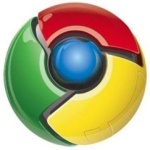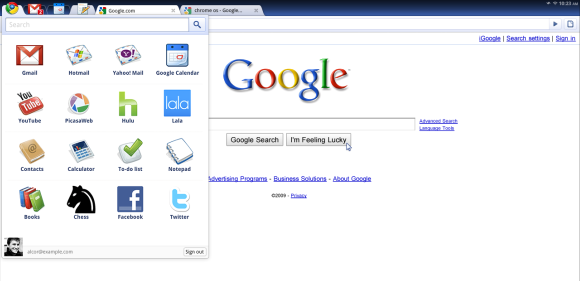 Last week Google finally unveiled their much-talked-about Chrome OS, and subsequently worked the tech community into a frenzy. The operating system certainly lived up to Google’s initial promises of being browser-centric – it is basically just the Chrome web browser atop a custom Linux kernel.
Last week Google finally unveiled their much-talked-about Chrome OS, and subsequently worked the tech community into a frenzy. The operating system certainly lived up to Google’s initial promises of being browser-centric – it is basically just the Chrome web browser atop a custom Linux kernel.
It does everything you’d expect from a browser, along with the welcome addition of upcoming HTML 5 additions which include media playback, drag and drop capabilities, and offline storage. These new HTML functions will allow web applications to behave even more like native OS applications, and will ultimately allow Chrome OS to feel less limited in its capabilities. (You can read a more extensive overview of the OS over at Gizmodo.)
With cloud computing being such a hot topic these days, Google deserves credit for pushing forward with Chrome OS and banking on an operating system that is entirely focused on the Web. They could have played it safe and just released an easy to use Linux distribution with deep web application integration – but no.
Chrome OS is a momentous step towards making the fuzzy concepts of cloud computing more of a distinct reality. What follows are a few reasons why I think it matters, and how it will change the computing landscape by bringing us closer to the cloud than ever before.

Why should we care?
The Chrome OS announcement has led to all sorts of prognostication across the web. Some have already determined that it will “fail big time“, whereas others like Robert Scoble have concluded that it has “already won.” My personal feelings lean towards those of the Chrome OS lovers. I don’t think it will particularly redefine our computing habits anytime soon, but I do find it an ingenious step by Google to get users focused on the Internet and web applications – their bread and butter.
Google has proven time and again that the Internet is their domain, especially compared to competitors like Microsoft or Yahoo. Android is their albatross for dominating the mobile web experience, and Chrome OS will share a similar fate for netbooks (and no, the existence of Android netbooks is not lost on me either).
Putting the Net back in netbooks
The original netbooks, the Asus Eee 700 series, were famously released with only 4GB of solid state storage in Fall 2007. At that time, even ultraportable laptops contained hard drives that racked up hundreds of gigs of storage. But the Eee didn’t need much storage, we were told, because they were built for working primarily on the Web. Since then, netbooks have come to resemble laptops with many today featuring hard drives around 160GB or more.
While I’m certainly not going to complain about the progress netbooks have made over the past two years, it’s worth noting how little they resemble their moniker now. And with new CPUs and nVidia’s Ion chipset, they’ll soon be powerful enough to play high definition video, not to mention 3D games.
Chrome OS will bring us back to that original ideal of a small and cheap machine that forces us to embrace the Web. Considering that the OS won’t even support hard drives (just solid state storage), it almost seems like a second coming for the true netbook. Few manufacturers will want to include high-capacity solid state drives in Chrome OS machines, which means that Chrome OS users will be relying more on online storage.
It will lead to even cheaper computing devices
Since you can currently get a decent netbook between $200-$400 today, I suspect we’ll be seeing Chrome OS devices at an even lower price – perhaps ultimately as low as around $50-$100. We still haven’t heard any pricing information from Google, but I don’t see how it would be in their interest to make these machines overly expensive.
They’ll most likely be as cheap as possible to make them extra enticing as secondary, or even tertiary machines. And of course, the more people that hop on the Chrome OS, the more people are lead to use Google services.
Healthy competition between Chrome OS and Android
Soon after the Chrome OS announcement, Google co-founder Sergey Brin dropped a quiet bombshell on the media – Chrome OS will eventually converge with Android. This is something that will probably happen far down the line, and most likely not in the way we expect.
When asked when we could expect this convergence by CNET, Google responded:
As Sundar [Pichai, Google’s vice president of product management] said in his presentation, we’re reaching a perfect storm of converging trends where computers are behaving more like mobile devices, and phones are behaving more like small computers.
Having two open source operating systems from Google provides both users and device manufacturers with more choice and helps contribute a wealth of new code to the open source community.
For now, it seems that the existence of the two projects will allow Google to build up a code base that is both aimed at the mobile and netbook segments. Chrome OS features may pop up in Android, and vice versa – all of which may eventually lead to unified operating system.
Summing up
Ultimately, Chrome OS isn’t something that’s going to make people leave their Windows and Mac computers in droves. But it does have the potential to carve out a strong niche as the platform behind secondary computers (even more so than netbooks today), and it will lead to even more reliance on cloud-based services.
About the author:
Devindra Hardawar is a tech/film blogger and podcast host. You can find him writing at the Far Side of Tech and Slashfilm.




























